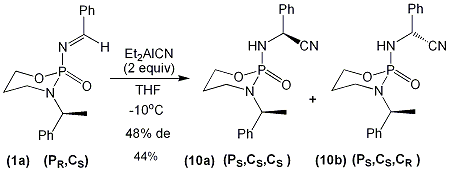1,2-Additions
to Activated Imines
There are no literature reports
of imines activated by chiral phosphorus auxiliaries. Thus,
we set out to develop suitable methodology for the synthesis
of a novel class of enantiomerically pure imine (1).
These are potential precursors to many biologically important
building blocks such as α-aminophosphonic
acids (2),
α-amino acids
(3), β-amino
acids (4),
α-branched amines
(5), α,α-dibranched
amines (6)
and aziridines (7)
(figure 1).

Figure 1
We recently developed a synthetic
route to this class of imines (1). Starting
from the commercially available (S)-α-methylbenzylamine
(8) the precursor phosphorodiamidate (9)
was synthesized in four steps. This included separation of a
diastereomeric mixture of phosphoramidochloridates by column
chromatography in order to yield the desired homochiral substrates.
X-Ray analysis of phosphorodiamidate (9) allowed
for the assignment of the absolute stereochemistry of this substrate.
Following considerable experimentation suitable conditions were
found for synthesis of both the corresponding aldimines (1a)
and the more synthetically challenging ketimines (1b)
(scheme 1) [1]. We modified conditions employed by
Davis and Ellman for the synthesis of enantiomerically pure
sulfinimines [2,3].

Scheme 1
Our preliminarily 1,2-addition
reactions of cyanide nucleophiles to the benzaldehyde derived
imine (1a) proceeded with moderate levels of
diastereoseletivity (up to 48% de) (scheme 2) [1]. The major
addition product was obtained in a diastereomerically pure form,
following recrystallization of the diastereomeric addition products
(10a) and (10b). We intend
to utilize X-Ray analysis in order to determine the absolute
stereochemistry of our major addition product, and thus shed
light upon the stereochemical outcome of this reaction.

Scheme 2
Recently, we have developed a
“one-pot” variant of our imine formation / nucleophilic
addition protocol. Thus, addition of the nucleophile is now
possible without prior purification of the imine. In future
we hope to extend this methodology for the synthesis of other
classes of aldimines and ketimines including aliphatic, and
other enolizable derivatives, as well as those that are potential
precursors to both natural and unnatural α-aminoacids.
[1] N. Abu-Thabit, I. Forristal, unpublished
results, Masters Thesis, KFUPM, May 2005.
[2] P. Zhou, B. C. Chen, F. A. Davis, Tetrahedron, 2004,
60, 8003.
[3] J. A. Ellman, T. D. Owens, T. P. Tang, Acc. Chem. Res.,
2002, 35, 984.

